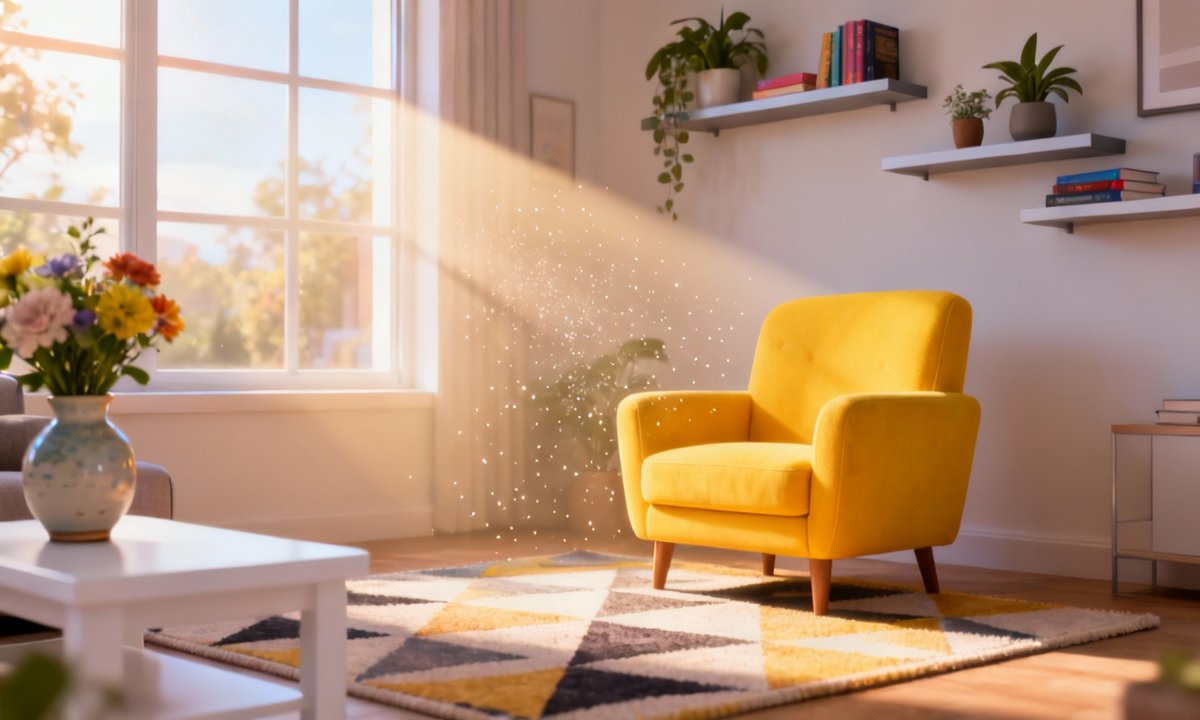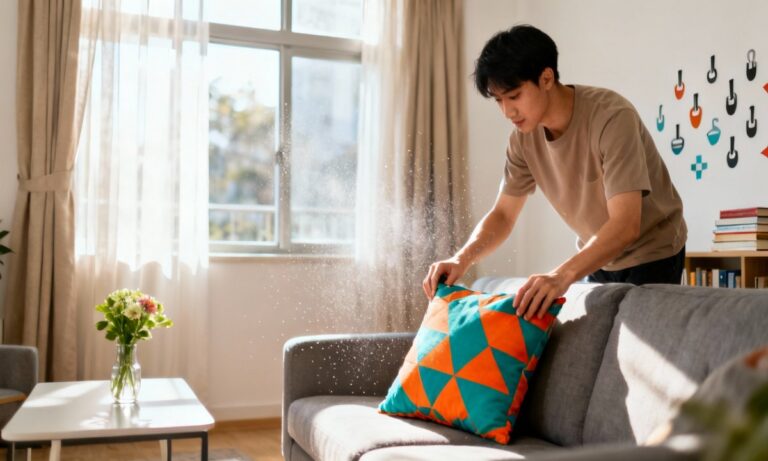Transforming your home into a haven of calm and joy begins with understanding how color and light subtly shape our everyday moods. Whether you seek tranquility, creative energy, or a warm, inviting vibe, leveraging these elements is essential for calming home interiors that uplift and nurture. This guide unpacks the science, strategies, and actionable design tips to create a peaceful environment that supports your well-being.
Unlocking Emotional Wellness Through Interior Design
Designing mood-boosting interiors enhances daily life, creating spaces that feel uniquely yours. By mindfully selecting hues and light sources, you can actively influence the emotional atmosphere of each room. This intentional approach to wellness design ensures your home truly resonates with your desired feelings.
The Psychology of Color in Interior Design
Color is far more than mere decoration; it fundamentally impacts our emotions and behaviors. This is the core of color psychology in interior design. For centuries, designers have intentionally used specific shades to evoke serenity, inspiration, or comfort within home spaces. Scientific research confirms colors can spark both positive and negative responses. The key is harnessing their power purposefully to design rooms that reflect how you want to feel (read more here).
Blue is widely celebrated for its calm and soothing qualities. Bedrooms and bathrooms drenched in soft blue hues are known to help reduce stress, lower anxiety, and support better sleep. This makes it an excellent choice for a restful sanctuary (source).
Green effortlessly reconnects us with nature, encouraging feelings of deep relaxation and harmony. It is often recommended for bedrooms and living rooms, where green helps balance energy and fosters a truly reparative, restorative ambiance (learn more here).
Yellow vibrant tones lift spirits and inject optimism, making it ideal for bustling kitchens and informal living areas. However, moderation is crucial, as excessive yellow may potentially overstimulate or agitate. Red ignites passion and energy, excellent for accent walls, yet overuse can overwhelm. Purple sparks creativity, and versatile neutrals like white or gray offer an elegant, serene backdrop for any room (explore more from Foyr).
Choosing Hues for Every Room
The emotional impact of color should thoughtfully guide your choices for each room within your home. Tailoring your palette ensures every space serves its unique purpose and desired mood.
For the bedroom, soft blues, muted greens, lavenders, and whites instill peace and promote restful sleep (read insights). In the living room, golden yellows, beige, and earthy tones foster welcoming warmth, while cool blues or greens aid relaxation.
Vibrant reds, oranges, and yellows can stimulate appetite and social interaction in the kitchen. For the bathroom, crisp whites, soft blues, or natural hues create a refreshing spa-like serenity. A home office benefits from light blue or soft green to boost productivity, and warm neutrals can support focused concentration. For those tackling budget or space constraints, discover clever color solutions in our guide to affordable DIY decor.
Lighting Techniques for a Calmer Space
Illumination profoundly influences how we perceive color and experience our spaces, forming a cornerstone of wellness design. Maximizing daylight is vital, with biophilic design demonstrating that natural light boosts mood, encourages good sleep, and enhances relaxation. Use sheer curtains, strategically placed mirrors, and unobstructed windows to usher sunbeams throughout your rooms.
For times when sunlight isn’t enough, artificial lighting effectively fills the gap. The trick lies in choosing the right type, tone, and placement to complement your desired atmosphere.
Cool, bright lighting is best suited for offices and kitchens where focus and energy are necessary for daily tasks. Conversely, warm, soft lighting is ideal for bedrooms and living rooms, actively encouraging unwinding and profound comfort. Layered lighting, combining ambient, task, and accent lights, allows you to adjust a room’s mood and function throughout the day (resource). This layering approach ensures flexibility, letting you dial up vibrancy or dial down for cozy calm as needed. Explore more smart lighting tweaks in our post on essential smart home upgrades.
Optimizing Natural Light in Your Home
Making the most of daylight transcends mere design; it is a powerful wellness strategy. Arrange seating near windows, opt for lighter drapes, and strategically add reflective decor elements to boost brightness. Circadian lighting, which intelligently mimics the sun’s natural movement, supports our internal clocks and can significantly ease daily stress, promoting overall well-being.
Harmonizing Color and Light for Mood-Boosting Interiors
Truly beautiful mood boosting interiors arise when you thoughtfully marry calming color schemes for homes with intentional lighting design. This synergy creates an environment that nurtures and uplifts its inhabitants.
For restful bedrooms, partner soft blue walls with gentle bedside lamps using dimmable bulbs. Living rooms designed for lively conversation might feature bold color pops alongside bright LED ceiling fixtures, setting an energetic tone.
Innovative Home Interior Lighting Ideas
Try these engaging mood-boosting lighting projects to enrich your home’s emotional atmosphere. Each small change can make a significant difference.
Install dimmer switches in key rooms for instant mood control, allowing you to adjust brightness effortlessly. Opt for color-changing smart bulbs to adapt environments as your needs or moods evolve throughout the day.
Create zone lighting by using desk lamps, wall sconces, and LED strips to highlight distinct areas or functions. Frame art or plants with soft accent lights for a subtle, soothing touch. Blend layered lighting with an open, airy arrangement for maximum tranquility, even within compact apartments.
Practical Steps: Cultivating a Mindful Home Environment
Ready to start cultivating a mindful interior design from the ground up? Use these expert tips for creating calming interiors that resonate with peace and happiness.
Start with a color mood chart to thoughtfully select a palette that suits your emotional goals and aspirations (see here). Balance vibrant tones with plenty of neutral colors to prevent overstimulation, ensuring a serene environment.
Integrate natural materials like wood, houseplants, and stone elements to boost your stress free home ideas. Reference our biophilic style guide for more inspiring connections to nature. Adjust regularly: as family needs or tastes change, don’t hesitate to refresh your palette or update lighting (source).
Highlight key areas: use accent lighting and color splashes in spaces where you desire increased energy, such as work nooks or creative corners. For creative, contemporary decor trends, our article on minimalist home decor trends is a must-read for modern inspirations.
Embracing Color Therapy for Home Refresh
Do not underestimate the profound power of color therapy within your home. Even small updates, like a pastel throw blanket or an energizing yellow artwork, can create a notable mood shift. Paint a statement wall, swap out old lampshades, or bring in nature-inspired pigments for a stress-free refresh that invigorates your space.
Frequently Asked Questions About Calming Interiors
Q: What are the best colors for reducing stress at home?
A: Soft blues, gentle greens, and neutral tones like white or beige are widely recognized for their calming effects. Use them in main living spaces to create a pervasive sense of tranquility and peace (research).
Q: How can I use lighting to enhance my mood?
A: Take advantage of natural daylight wherever possible to brighten your space. Layer artificial light using dimmers and choose warm bulbs in relaxing spaces, and cooler ones in productive areas. Circadian lighting helps align your daily rhythms naturally.
Q: How can I create a serene bedroom with color and light?
A: Paint walls in pale blue, soothing lavender, or gentle sage green. Add soft, diffused task lighting on either side of the bed for a balanced glow. Keep clutter minimal and introduce soft, textural elements for ultimate calm and comfort.
Q: What’s the simplest way to transform a room on a budget?
A: Try swapping accent decor with mood-boosting colors, or update lampshades and curtains for a fresh look. Check out our practical guide for step-by-step ideas to achieve stunning results on a budget: DIY Decor on a Budget.
Q: Are there US-specific color and lighting trends for calming interiors?
A: Absolutely. American homes are increasingly drawing from Scandinavian minimalism, embracing biophilic design, and integrating smart lighting for adaptive, wellness-focused interiors. These trends are emerging across all major US cities, reflecting a desire for more serene living.
Conclusion: Your Home, Your Sanctuary
Designing calming color schemes for homes with intentional lighting brings measurable benefits to your daily well-being, relationships, and focus. Remember, blending soothing hues with mindful illumination is an ongoing, evolving process. Adapt as your family, needs, and preferences evolve to keep your space aligned with your life.
For more hands-on ideas, inspiration, and step-by-step advice, explore:
- DIY Decor Ideas for Every Room
- Biophilic Design for Wellbeing
- Decor for Tiny Apartments
- Minimalist Home Trends
Embrace the journey of creating mood boosting interiors—let your home become a true sanctuary for body and mind. With the right palette, lighting, and intentional design, every room can be a source of comfort and happiness year-round, enriching your daily experience.



